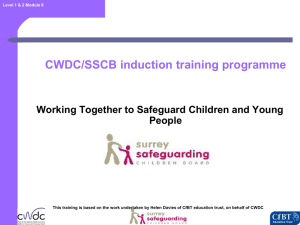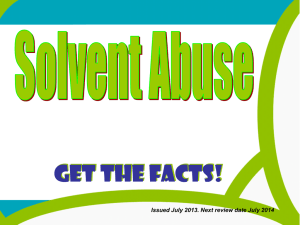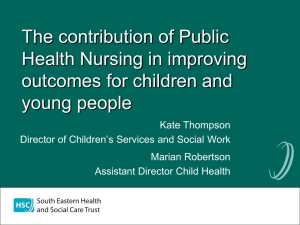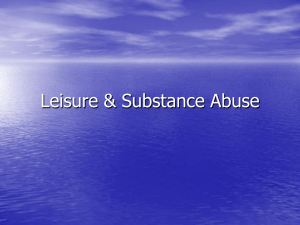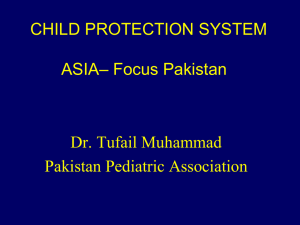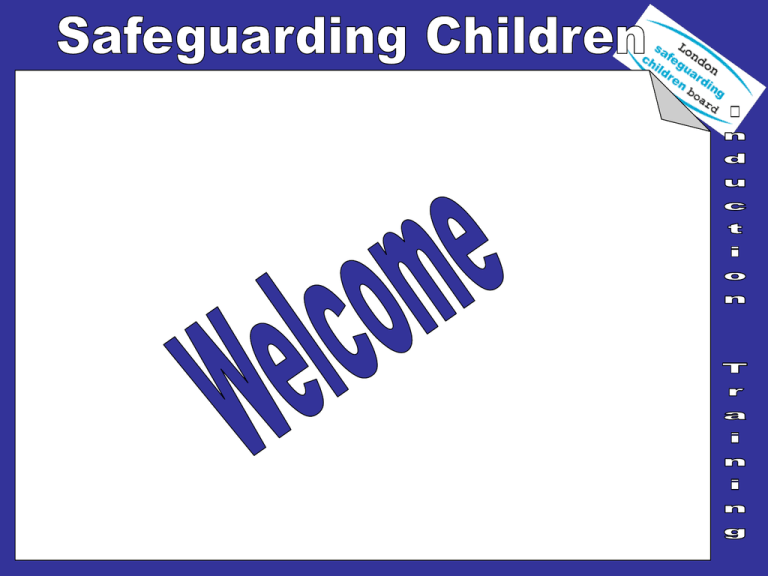
The aim of this brief training session is to raise
awareness regarding the safeguarding of children and
to remind you of your responsibilities whenever you
have a concern about a child.
By the end of this session you will be aware of:
what is meant by the term safeguarding children;
the various levels of intervention and their
thresholds;
some signs and symptoms of possible abuse;
what you should do if you have a concern for a
child’s welfare or safety.
‘Ultimately, effective safeguarding of children can only
be achieved by putting children at the centre of the
system and by every individual and agency playing
their full part, working together to meet the needs of
our most vulnerable children.’
(Source: Working Together to Safeguard Children, 2013)
Professionals in all agencies have a responsibility
to refer a child to LA children's social care when it is
believed or suspected that the child:
Has suffered significant harm;
Is likely to suffer significant harm.
(Source: London Safeguarding Children Board Child
Protection Procedures, 5th Edition)
Professionals in all agencies have a responsibility to
refer a child to LA children's social care when it is
believed or suspected that the child:
Has a disability, developmental and welfare needs
which are likely only to be met through provision of
social work led family support services (with
agreement of the child's parent) under the Children
Act 1989;
Is a Child in Need whose development would be
likely to be impaired without provision of services.
(Source: London Safeguarding Children Board Child Protection
Procedures, 5th Edition)
In this establishment, the person you should
talk to whenever there is a concern about a
child’s welfare is:
or, in their absence:
Who could become involved in supporting the
family and what might they be able to offer?
Who would become involved in response to this
situation (by making child protection enquiries, by
contributing information and opinion to any
enquiries/assessment or by offering the family
support as part of any plan?)
Note that this is the same family as in the earlier
case. The difference is that 8 months have passed
with little or no support for the family.
Every assessment should be focused on outcomes,
deciding which services and support to provide to
deliver improved welfare for the child.
(Source: Working Together to Safeguard Children, 2013)
Five key themes about the voice of the child have
been identified …. In too many cases:
the child was not seen frequently enough by the
professionals involved, or was not asked about
their views and feelings
agencies did not listen to adults who tried to speak
on behalf of the child and who had important
information to contribute
parents and carers prevented professionals from
seeing and listening to the child
Five key themes about the voice of the child have
been identified …. In too many cases:
practitioners focused too much on the needs of the
parents, especially vulnerable parents, and
overlooked the implications for the child
agencies did not interpret their findings well enough
to protect the child.
(Source: The voice of the child: learning lessons from serious case
reviews, Ofsted 2011)
Safeguarding and promoting the welfare of children is
defined for the purposes of this guidance as:
protecting children from maltreatment;
preventing impairment of children's health or
development;
ensuring that children grow up in circumstances
consistent with the provision of safe and effective
care; and
taking action to enable all children to have the best
outcomes.
(Source: Working Together to Safeguard Children, 2013)
Where need is relatively low level individual services
and universal services may be able to take swift
action. For other emerging needs a range of early
help services may be required, coordinated through
an early help assessment ….
(Source: Working Together to Safeguard Children, 2013)
A child in need is defined under the Children Act 1989
as a child who is unlikely to achieve or maintain a
satisfactory level of health or development, or their
health and development will be significantly impaired,
without the provision of services; or a child who is
disabled. In these cases, assessments by a social
worker are carried out under section 17 of the
Children Act 1989.
(Source: Working Together to Safeguard Children, 2013)
If at any time it is considered that the child may be
a child in need as defined in the Children Act 1989,
or that the child has suffered significant harm or is
likely to do so, a referral should be made
immediately to local authority children’s social
care.
(Source: Working Together to Safeguard Children, 2013)
Where there are child protection concerns
(reasonable cause to suspect a child is suffering or
likely to suffer significant harm) local authority
social care services must make enquiries and
decide if any action must be taken under section 47
of the Children Act 1989.
(Source: Working Together to Safeguard Children, 2013)
‘harm’ means ill-treatment or the impairment of
health or development, including, for example,
impairment suffered from seeing or hearing the illtreatment of another;
‘development’ means physical, intellectual,
emotional, social or behavioural development;
‘health’ means physical or mental health; and
‘ill-treatment’ includes sexual abuse and forms of
ill-treatment which are not physical.
(Source: Children Act 1989 as amended by the Adoption and
Children Act 2002)
Where the question of whether harm suffered by a
child is significant turns on the child’s health or
development, his health or development shall be
compared with that which could reasonably be
expected of a similar child.
(Source: Children Act 1989)
s47
s17
Child
protection
needs
Complex
support
needs
Common
Assessment
Framework
Additional
support
needs
Everyday
needs
s47
s17
Child
protection
needs
Complex
support
needs
Common
Assessment Framework
Additional
support
needs
Everyday
needs
s47
s17
Child
protection
needs
Complex
support
needs
Common
Assessment Framework
Additional
support
needs
Everyday
needs
s47
s17
Child
protection
needs
Complex
support
needs
Common
Assessment Framework
Additional
support
needs
Everyday
needs
s47
s17
Child
protection
needs
Complex
support
needs
Common
Assessment Framework
Additional
support
needs
Everyday
needs
s47
s17
Child
protection
needs
Complex
support
needs
Common
Assessment Framework
Additional
support
needs
Everyday
needs
s47
s17
Child
protection
needs
Complex
support
needs
Common
Assessment Framework
Additional
support
needs
Everyday
needs
s47
s17
Child
protection
needs
Complex
support
needs
Common
Assessment Framework
Additional
support
needs
Everyday
needs
NEGLECT
SEXUAL ABUSE
PHYSICAL ABUSE
EMOTIONAL ABUSE
Physical Abuse
Physical abuse may involve hitting, shaking, throwing,
poisoning, burning or scalding, drowning, suffocating,
or otherwise causing physical harm to a child. Physical
harm may also be caused when a parent or carer
fabricates the symptoms of, or deliberately induces,
illness in a child.
(Source: Working Together to Safeguard Children 2013, p85)
Sexual Abuse
Sexual abuse involves forcing or enticing a child or young person
to take part in sexual activities, not necessarily involving a high
level of violence, whether or not the child is aware of what is
happening. The activities may involve physical contact, including
assault by penetration (for example, rape or oral sex) or nonpenetrative acts such as masturbation, kissing, rubbing and
touching outside of clothing. They may also include non-contact
activities, such as involving children in looking at, or in the
production of, sexual images, watching sexual activities,
encouraging children to behave in sexually inappropriate ways,
grooming a child in preparation for abuse (including via the
internet). Sexual abuse is not solely perpetrated by adult males.
Women can also commit acts of sexual abuse, as can other
children.
(Source: Working Together to Safeguard Children 2013, p86)
Neglect
Neglect is the persistent failure to meet a child’s basic physical
and/or psychological needs, likely to result in the serious
impairment of the child’s health or development. Neglect may
occur during pregnancy as a result of maternal substance abuse.
Once a child is born, neglect may involve a parent or carer failing
to:
provide adequate food, clothing and shelter (including exclusion
from home or abandonment);
protect a child from physical and emotional harm or danger;
ensure adequate supervision (including the use of inadequate
care-givers); or
ensure access to appropriate medical care or treatment.
It may also include neglect of, or unresponsiveness to, a child’s
basic emotional needs.
(Source: Working Together to Safeguard Children 2013, p86)
Emotional Abuse
Emotional abuse is the persistent emotional
maltreatment of a child such as to cause severe and
persistent adverse effects on the child’s emotional
development. It may involve conveying to children that
they are worthless or unloved, inadequate, or valued
only insofar as they meet the needs of another person.
It may include not giving the child opportunities to
express their views, deliberately silencing them or
‘making fun’ of what they say or how they
communicate.
cont. ….
Emotional Abuse (cont.)
It may feature age or developmentally inappropriate
expectations being imposed on children. These may
include interactions that are beyond the child’s
developmental capability, as well as overprotection
and limitation of exploration and learning, or
preventing the child participating in normal social
interaction. It may involve seeing or hearing the illtreatment of another. It may involve serious bullying
(including cyberbullying), causing children frequently
to feel frightened or in danger, or the exploitation or
corruption of children. Some level of emotional abuse
is involved in all types of maltreatment of a child,
though it may occur alone.
(Working Together to Safeguard Children 2010, p85)
Exercise:
What are the signs of:
Physical Abuse
Sexual Abuse
Emotional Abuse
Neglect
Children who may be more vulnerable to being
harmed
babies and younger children
disabled children
children who are isolated
children who are already thought of as a problem
(e.g. children in care; children in secure
accommodation, children with
emotional/behavioural difficulties)
Over two thirds (68%) of children killed at the
hands of another person in England and Wales
are aged under five years.
Infants aged under one year are more at risk of
being killed at the hands of another person than
any other single year age group in England and
Wales.
Source: NSPCC, 2014
42% of children who are the subject of a child
protection plan are under 4 years old.
Source: Department for Education, 2013
Disabled children are:
3.1 times more likely to be sexually
abuse;
3.8 times more likely to be neglected;
3.8 time more likely to be physically
abused;
3.9 time more likely to be emotionally
abused.
(Source: Sullivan and Knutson, 2000)
Professionals must take special care to help safeguard
and promote the welfare of children and young people
who may be living in particularly stressful
circumstances. These include families:
living in poverty;
where there is domestic violence;
where a parent has a mental illness;
where a parent is misusing drugs or alcohol;
where a parent has a learning disability;
that face racism and other forms of social isolation;
living in areas with a lot of crime, poor housing and
high unemployment.
Questions should be:
Necessary – the purpose of questions at this stage is
to establish whether or not there is a concern, not to
interrogate the child or conduct an investigation.
Non-leading – do not use questions that suggest an
answer.
Open – avoid questions that invite only a ‘yes’ or ‘no’
answer.
Always report any concern about the welfare of any
child.
Always telephone the local authority children’s
social care services without delay if you suspect
that a child has suffered or is at risk of suffering
harm.
Parents should be told of your concern and that you
intend to refer (unless informing parents would
place the child at risk of harm) – see London
Procedures – if in doubt, seek advice.
You do not need parental agreement to make a
referral in respect of a child at risk of harm.
Whenever you make a telephone referral, always
back this up in writing (within 48 hours) using your
local authority’s referral form.
If your referral is in respect of support for a Child-in
Need where the threshold of significant harm has not
been reached, a written referral can be submitted to
the local authority children’s social care services.
This is sometimes made after assessment under the
Common Assessment Framework has indicated that
it is required.





